Wednesday, January 31, 2024
< + > How one triage center delivers more culturally sensitive mental health and addiction care
< + > Healthcare should broaden efforts to scale genAI, say IT leaders
< + > An Urgent Call for AI Solutions to Tap Evidence-Based Research Best Practices
The following is a guest article by Lars Maaløe, Co-Founder and CTO at Corti
The integration of Artificial Intelligence (AI) across healthcare—in clinical workflows, care coordination, business processes, logistics, revenue cycles, first responder and emergency services, and others—is a development that holds immense promise. As a technologist, academic, and entrepreneur deeply immersed in this field, I’ve witnessed firsthand the transformative power of AI in healthcare. As a result, I am deeply optimistic about AI’s benefits as a support tool for doctors, nurses, and other clinicians.
However, the credibility and success of AI in healthcare have reached an inflection point. As an industry, we need to quickly move from “we could do” to “we have done” in the adoption of AI and other intelligent automation tools for this technology to realize its potential.
To bridge this gap, the implementation of AI solutions in healthcare should honor and remain deeply rooted in the industry’s history of evidence-based research as much as possible to achieve its greatest positive impact. As optimistic as the healthcare industry is about AI, its ultimate successful adoption hinges on a crucial factor: how AI is supported by evidence.
Evidence is Foundational to AI’s Long-Term Success
The reliance on evidence-based data and reporting in healthcare is a time-honored tradition critical for making informed, safe, and effective patient care decisions. As AI gains momentum and grows in potential, this reliance becomes even more pivotal. AI systems process vast amounts of data, and their outputs can significantly influence clinical workflows. Therefore, ensuring that these AI systems are grounded in reliable, scientifically validated data is imperative for their acceptance and effectiveness in clinical settings.
A fitting example is a recent study published in Nature titled “A Retrospective Study on Machine Learning-Assisted Stroke Recognition for Medical Helpline Calls,” highlighting AI’s utility in improving stroke diagnosis during medical helpline calls. Stroke, as a major health concern, demands accurate and timely recognition for effective treatment. This study is pivotal for showcasing how AI enhances decision-making in critical situations. It finds that AI-supported workflows can outperform traditional stroke decision-making in meaningful and measurable ways to greatly improve time to relevant care.
Notably, as described in the study discussion, “Our results showed that a machine learning framework can substantially improve stroke recognition in medical helpline calls compared to solely relying on human call-takers. This improvement was observed across all performance metrics and for basic patient demographics (age and sex).”
There is Urgency in Establishing Trust in AI
AI must align with the established practices and standards of healthcare knowledge to gain credibility in this sector. Like any new medical intervention or tool, AI applications in healthcare should undergo stringent development, testing, and validation processes. The study involving the analysis of medical helpline call data for stroke recognition serves as an exemplary model of how AI is being developed and validated using rigorous scientific methods.
For example, ambient clinical voice (ACV) has emerged as a top priority for most health systems and a focus area for Healthcare IT Today. However, for a physician to trust an AI to assist them with ambiently documenting and assigning a set of healthcare codes, e.g., ICD-10, they need to understand the rigorous validation supporting the technology. In my recent video interview on this topic, I explain the research that went into our large language models and predictive modeling tools to improve the clinician-patient conversation and, ultimately, the long tail of healthcare coding, billing, and reimbursement processes.
Strong, evidence-based foundations for AI applications and use cases in healthcare are vital for the current applications of AI and its future advancements. Ensuring AI applications are safe, effective, and dependable through evidence-based research is a responsibility that must be upheld.
It’s Not Just About the Tech, AI Also Benefits from Interdisciplinary Collaboration
The success of AI for stroke recognition also highlights the importance of interdisciplinary collaboration. In this example, neurologists, data scientists, machine learning experts, and emergency medical professionals came together. They combined their expertise to develop a solution that enhances prehospital care quality.
This study is a milestone in a much larger journey and represents the fusion of medical knowledge with cutting-edge technology, driven by a shared commitment to advancing healthcare. Such collaborative efforts are essential for successfully developing and implementing AI solutions in the industry.
Scientific Methods and Rigorous Processes are Stalwart Guides During Transformational Times
As the healthcare industry navigates its way through this AI (r)evolution, the emphasis should be on rigorous validation, ethical considerations, and a focus on improving patient outcomes. These principles will guide the successful integration of AI into healthcare workflows, ultimately enhancing the quality of care provided to patients.
As thought leaders and innovators in this field, it is our duty to ensure the development of AI tools also adheres to the highest standards of scientific rigor and ethical practice. In doing so, we can pave the way for a future where AI and medical expertise work in harmony to deliver innovative, safe, effective, and beneficial patient care.
 About Lars Maaløe
About Lars Maaløe
Lars Maaløe is the Co-Founder and CTO at Corti and Adjunct Associate Professor of Machine Learning at Technical University of Denmark (DTU).
< + > Turquoise Health Raises $30M Series B Financing, Expanding Healthcare Pricing Platform Offerings
Price Transparency is the Foundation for Eliminating the Financial Complexity of Healthcare
Turquoise Health, an end-to-end healthcare pricing platform, today announced a $30M Series B investment led by Adams Street Partners, with participation from Yosemite, as well as existing investors Andreessen Horowitz and BoxGroup. Turquoise will use the funding to further support transparent pricing workflows across its customer base of over 160 healthcare organizations.
“Healthcare pricing remains frustratingly opaque for many industry stakeholders, including patients,” says Tom Bremner, Partner at Adams Street, who will join the company’s Board of Directors. “Turquoise tackles this problem head-on with a sophisticated, multi-stakeholder platform that ultimately makes healthcare pricing and packaging look easy. I am excited to partner with the team as they scale towards a seamless healthcare transaction.”
Price transparency data has become critical since its introduction through 2021 federal regulation for hospitals and insurers. With these negotiated rates and AI at its core, the Turquoise platform recently expanded to support payer and provider contract management, consumer transparency compliance, and advanced platform-based analytics. The new capital will help facilitate onboarding from recent customer expansion into these products.
“As we see price transparency legislation take shape through 2027 and beyond, Turquoise accelerates support for healthcare organizations as they embed transparency and simplicity at every step in the transaction,” says Turquoise CEO, Chris Severn.
Turquoise has developed a prominent industry voice on price transparency requirements. Their expertise and new platform offerings have attracted marquee customers such as The Mass General Brigham Health System. “We’re eager to work with Turquoise towards simplified administration and a clearer conversation with our patients, plans, and care providers around value,” says the system’s CFO, Niyum Gandhi.
“The complexity and opacity of healthcare pricing disproportionally burdens patients undergoing high-cost treatment like cancer therapy,” said Matt Bettonville, Investor at Yosemite. “Price is the mechanism that allows market forces to work, so the lack of clear pricing in healthcare has been a major driver of inefficiency in the industry. As the leader in aggregating and normalizing healthcare pricing data, Turquoise is advancing price transparency to help lower healthcare costs and empower patients to make informed care decisions.”
About Turquoise Health
Turquoise Health is the industry’s leading healthcare pricing platform. At the intersection of providers, payers, employers, life sciences organizations, and their patients, Turquoise builds products to eliminate the financial complexity of healthcare. Learn more at turquoise.health.
About Adams Street Partners
Adams Street Partners is a global private markets investment manager with investments in more than 30 countries across five continents. The firm is 100% employee-owned and manages $58 billion in assets under management. Adams Street strives to generate actionable investment insights across market cycles by drawing on over 50 years of private markets experience, proprietary intelligence, and trusted relationships. Adams Street has offices in Austin, Beijing, Boston, Chicago, London, Menlo Park, Munich, New York, Seoul, Singapore, Sydney, and Tokyo. Visit adamsstreetpartners.com
About Yosemite
Yosemite partners with leading researchers and innovative entrepreneurs working to make cancer non-lethal within our lifetime. The firm deploys capital from early non-profit grantees through late-stage companies to fund advancements across the oncology ecosystem. We leverage our differentiated scientific network to create and finance companies that drive the translation of new therapies in patients and optimize the patient experience. Yosemite aims to meaningfully accelerate the technology, treatments, and standard of care that have the power to improve the health and lives of cancer patients. For more information, please visit yosemite.co.
Originally announced January 23rd, 2024
Tuesday, January 30, 2024
< + > Slow and steady uptake of genAI in APAC healthcare in 2024
< + > Stanford uses AI to navigate health information sharing with teens and their families
Monday, January 29, 2024
< + > 2024 Health IT trends in India: A spotlight on genAI, robotics
< + > How virtual sitter services saved St. Luke’s $1.5M in 2023
< + > CIO Podcast – Episode 67: Cybersecurity and Digital Transformation with Inderpal Kohli
For the 67th episode of the CIO podcast hosted by Healthcare IT Today, we are talking to Inderpal Kohli, Vice President and CIO at Englewood Health about cybersecurity and digital transformation! We kick this episode off by discussing Kohli’s approach to cybersecurity, where he then shares a personal recommendation about cybersecurity for all healthcare CIOs. Then Kohli tells us all about his journey in digital transformation. From his personal experience, we discuss what it takes to successfully drive digital transformation. Next, we talk about generative AI. Kohli shares his views on generative AI and we debate how all CIOs should be approaching generative AI. Lastly, we end this episode with Kohli sharing the best piece of advice he’s been given in his career.
Here’s a look at the questions and topics we discuss in this episode:
- How are you approaching cybersecurity? What’s one security thing you’ve done that you’d recommend all healthcare CIOs do?
- Please share your digital transformation journey.
- What does it take to drive successful digital transformation?
- What’s your view on generative AI? How should a CIO be approaching generative AI in healthcare?
- What IT topic are not enough people talking about that healthcare CIOs should be talking more about?
- What’s the best piece of advice you’ve been given in your career?
Now, without further ado, we’re excited to share with you the next episode of the CIO Podcast by Healthcare IT Today.
We release a new CIO Podcast every ~2 weeks. You can also subscribe to the Healthcare IT Today podcast on any of the following platforms:
NOTE: We’ll be updating the links below as the various podcasting platforms approve the new podcast. Check back soon to be able to subscribe on your favorite podcast application.
Thanks for listening to the CIO Podcast on Healthcare IT Today and if you enjoy the content we’re sharing, please rate the podcast on your favorite podcasting platform.
Along with the popular podcasting platforms above, you can Subscribe to Healthcare IT Today on YouTube. Plus, all of the audio and video versions will be made available to stream on HealthcareITToday.com.
We’d love to hear what you think of the podcast and if there are other healthcare CIO you’d like to see us have on the program. Feel free to share your thoughts and perspectives in the comments of this post with @techguy on Twitter, or privately on our Contact Us page.
We appreciate you listening!
Listen to the Latest Episodes
< + > Findhelp and Pennsylvania HIEs to build SDOH navigator
< + > Women’s Health in the Digital Health Market: What 2024 Has in Store
 The following is a guest article by Egle Jakimone, Product CEO at Kilo Health
The following is a guest article by Egle Jakimone, Product CEO at Kilo Health
In 2024, we are expecting to witness a significant change in women’s health, particularly centered around the transformative phase of menopause. The notable growth of female wellness apps is helping women to take an active role in managing their health. Additionally, the increased attention to women’s health topics is drawing interest from global players and investors.
As a lead of a holistic health product tailored to women, I have gathered some insights into what to expect from 2024 and how to come prepared.
Embracing the Menopause Boom in 2024
A significant part of the shift in women’s health is the impressive growth in the menopause market, expected to reach $24.4 billion by 2030, up from $15.4 billion in 2021. Why does this matter? Well, nearly 20% of the U.S. workforce, roughly 27 million women, are grappling with menopause challenges. Surprisingly, 40% say these symptoms make it harder for women to perform at work, and nearly one in five are considering leaving their jobs because of it.
Workplaces are starting to acknowledge menopause issues, such as European companies having certain policies. Over in Australia, unions are advocating for employers to offer menstrual and menopause leave. Investors are catching on, realizing that only 7% of femtech startups are shining a light on menopause.
Looking forward, 2024 is shaping up to be promising, with a bunch of investments flowing in, developing new solutions for women going through the menopause journey.
More and more women are breaking the silence about menopause, which has over 30 symptoms causing challenges in daily life. Finally, it’s becoming a topic of broader discussion in society, not just talked about in exclusive clubs or, worse, silently endured.
This is why businesses should increase their focus on providing solutions for women experiencing menopause, as it seems to become a promising field in 2024.
Simple Personalization is Not Enough Anymore
We have personalized nutrition and personalized medicine, and now we’re diving into more personalization in women’s health solutions, especially tailored to a woman’s menstrual cycle. It’s not just about dealing with periods; it’s about giving women insights and tools to manage their health across various life and cycle stages.
The digital women’s health market, covering fertility, prenatal care, postpartum support, gynecological solutions, and menopause management, is evolving. A key trend is the integration of these segments, recognizing their interconnected nature in addressing diverse health needs throughout different life stages. Think of it like getting customized workout recommendations based on where you are in your cycle.
Beyond physical well-being, there’s a growing emphasis on the connection between physical and mental health. In 2024, women’s health solutions will prioritize holistic approaches, acknowledging how physical well-being significantly impacts mental health. This comprehensive perspective is set to reshape the landscape, recognizing women’s health as a multifaceted journey requiring integrated support.
All in all, as we enter 2024, expect significant developments in women’s health, addressing critical issues such as menopause, personalization, and the seamless integration of digital technologies to enhance overall well-being across diverse life stages.
< + > Care Continuity Secures $10M in Funding to Fuel Growth in Patient Navigation
Today, Care Continuity, a leader in data-driven patient navigation serving some of the country’s largest health systems, payers, and ACOs, announced the close of $10 million in Series A-3 funding co-led by Empactful Capital and Viewside Capital Partners with participation from Flat Creek Capital and Loop 289 Limited Partners.
The funding will enable Care Continuity to further its mission of helping health systems, payers and ACOs employ an efficient patient and member-centered care journey, as well as make strategic investments in growth, product development, and further enablement of AI to enhance Care Continuity’s already strong patient navigation offerings.
“As health systems grow in complexity, the need for compassionate, patient-centered services that help patients along their care journey has increased exponentially,” said Brad Prugh, CEO at Care Continuity. “Health systems have invested heavily in building comprehensive healthcare networks and want to see their patients fully utilize these networks. That’s where Care Continuity thrives.”
“This funding will allow us to enhance our navigation platform in meaningful ways for both providers and patients. This includes employing AI to increase our ability to expand our reach and improve the efficiency in which we connect with more patients,” said Prugh.
In addition to assisting health systems in reducing patient leakage by providing patient-centered navigation, Care Continuity’s advanced analytics, purpose-built digital tools, and one-to-one concierge interactions also provide payers, ACOs, and other risk-bearing entities in healthcare with a quality medium to engage members and navigate them to network care.
“Care Continuity’s patient navigation solutions address many of the problems patients face in our fragmented healthcare system,” said Sal DeTrane, Managing Director at Empactful Capital. “By efficiently and compassionately navigating patients along their care journey, Care Continuity helps health systems, payers, and ACOs serve their patients and members while improving the integrity of their care networks.”
The announcement comes on the heels of impressive growth for the company, including a 60% Revenue CAGR, a 155% increase in navigated patients, and expansion of their product offering. The company has continued to build out its management team, including key hires in sales and marketing, technology, data science, and advisory services.
About Care Continuity
Founded in 2014, Care Continuity provides expert patient navigation solutions that are designed to bridge gaps in healthcare, providing seamless transitions between care settings, reducing network leakage, and promoting optimal health outcomes and patient satisfaction. Through a combination of advanced software, AI, and a dedicated team of care concierges, we help guide patients through their care journey while maintaining the integrity of the health system network. This translates to greater patient satisfaction, better health outcomes, and increased margins for our clients. To learn more, visit carecontinuity.com or follow us on LinkedIn.
About Empactful Capital
Empactful Capital, founded in 2016 by experienced healthcare professionals and investors, is a venture capital firm specializing in early and growth-stage opportunities within the healthcare sector. Our primary focus is on whole-person value-based models and behavioral health. Using targeted funds and industry expertise, we aim to quickly scale innovative companies. Through our pre-investment working engagement model, we thoroughly assess areas of strength and development to ensure alignment and drive success for the companies we invest in. In 2021, Empactful Capital served as the lead investor for Care Continuity from its first fund and co-led the most recent investment into The Company from its second fund.
Originally announced January 8th, 2024
Sunday, January 28, 2024
< + > Apollo Hospitals' new insurance claim support platform and more briefs
< + > Bonus Features – January 28, 2024 – 49% of orgs likely to invest in RCM tech in the next 18 months, v2 drafts of TEFCA Common Agreement and QHIN Technical Framework out, plus 27 more stories
Welcome to the weekly edition of Healthcare IT Today Bonus Features. This article will be a weekly roundup of interesting stories, product announcements, new hires, partnerships, research studies, awards, sales, and more. Because there’s so much happening out there in healthcare IT we aren’t able to cover in our full articles, we still want to make sure you’re informed of all the latest news, announcements, and stories happening to help you better do your job.
News and Studies
- The Sequoia Project released a bundle of TEFCA draft documents, including v2 drafts of the Common Agreement and QHIN Technical Framework. Interested stakeholders have until February 5 to provide feedback.
- About half (49%) of healthcare professionals are likely to invest in new RCM technology in the next 18 months, according to Salucro’s Healthcare Provider Fintech Insights Report. A similar percentage (48%) say timely patient collections are their biggest concern in 2024.
- Nearly 4 in 10 (38%) Americans with chronic pain report feeling depressed, and 44% report feeling anxious, according to a Hinge Health survey. Of those in pain, half say traditional physical therapy is too expensive.
- The latest analysis from Epic Research found two-thirds of patients maintain weight loss up to one year after they stop taking semaglutide or liraglutide, respectively sold under the names Ozempic and Wegovy.
Partnerships
- Wolters Kluwer’s Health Language Platform is now available through the Innovaccer platform.
- Autonomous coding software from Fathom is now available on the Google Cloud Marketplace.
- The Gemini Coder Platform and Gemini AutoCode solutions from Aidéo Technologies have been integrated with MedEvolve Effective Intelligence.
- Codeless platform Unqork launched a new patient portal in partnership with Spacial Health, a specialty health technology marketplace.
- Household accessibility service provider network Rosarium Health is working with Spatially Health to help clients build custom solutions that support independent living.
- Denver-based Integrated Physician Network announced a strategic partnership with Lumeris to enhance value-based care delivery.
Product and Company News
- Sexual health provider TBD Health launched its enterprise offering, with FOLX Health and Wisp as its initial customers.
- Workforce marketplace SnapCare announced its Transparent Pricing Promise, which will disclose pay rates and travel costs without markup.
- MRO earned the Validated Data Stream designation in the NCQA Data Aggregator Validation program.
- A Paytient end user survey found 92% of employees with a Health Payment Account are more satisfied with their benefits, while two-thirds report improved health.
Sales
- Florida Digestive Health Specialists chose eClinicalWorks and Sunoh.ai. In addition, Ohio-based Centerpoint Health integrated healow‘s no-show prediction AI model and increased its show rate by 24%.
- Maven Clinic selected WellTheory to provide autoimmune disease support to its employees.
- Independent specialty pharmacy Palmetto Pharm selected Inovalon ScriptMed Specialty as its pharmacy management software.
People
- Data governance platform provider Clearsense appointed Jason Rose as Chief Executive Officer, with founder and former CEO Gene Scheurer to remain on the Board of Directors.
- Emory Healthcare named Dr. Nitu Kashyap as Chief Health Informatics Officer, effective February 5.
- Outpatient mental health provider LifeStance Health appointed Dr. Ujjwal Ramtekkar as Chief Medical Officer.
- FHIR-enabled data exchange vendor 1upHealth appointed Andrea Kowalski as Chief Product Officer.
- Care access platform provider Kyruus Health appointed Harshit Shah as Chief Technology Officer.
- Cybersecurity vendor Anatomy IT named Patrik Vagenius as Chief Commercial Officer.
- Substance use management virtual clinic Pelago appointed Michael Reiff as Chief Product Officer and announced three promotions to C-level positions.
- Provider marketing and advertising agency Unlock Health appointed Kevin Thilborger as Chief Managed Care Officer and Chief Revenue Strategy Officer.
- Medication adherence insight vendor AdhereHealth named James Bradley as Executive Chairman of the Board.
- Conversational intelligence vendor Authenticx welcome Dr. Don Brown to its Board of Directors.
- Risk assurance firm First Health Advisory launched its six-member Strategic Advisory Board.
- Voice-enabled AI vendor Suki added six members to its advisory board.
If you have news that you’d like us to consider for a future edition of Healthcare IT Today Bonus Features, please submit them on this page. Please include any relevant links and let us know if news is under embargo. Note that submissions received after the close of business on Thursday may not be included in Bonus Features until the following week.
Friday, January 26, 2024
< + > HIMSS to showcase new modernized INFRAM at global conference
< + > HIMSSCast: Managing critical patient feedback in real time
< + > Health IT Leadership’s Role in Patient Data Security and Privacy
Moving towards an entirely digital world of healthcare can be very appealing in a lot of ways. Having everything digital means better interoperability, increased patient access, and more. However, with the ever-increasing cybersecurity threats and attacks moving more digital can also be very scary. And it is in these uncertain and scary times that people turn to their leaders for guidance. This leaves us with the big question of what role Health IT leadership plays in ensuring the security and privacy of patient data, and what strategies can leaders employ to address emerging cybersecurity threats.
We reached out to some fantastic leaders in our Healthcare IT Today Community for their insights into this big question. The following is what they had to say on the matter.
Ravi Soin, Chief Information & Security Officer at Edifecs
HIT leadership is critical to ensuring the security and privacy of patient data. A security breach can be potentially catastrophic to an organization and every leader must understand that this must be a strategic priority for their organization. Organizations that prioritize security and compliance will provide the appropriate training, tools, and technology to safeguard patient data and in turn, safeguard their business. Addressing emerging cybersecurity threats requires a comprehensive and proactive approach from leaders. This starts with continuous learning, fostering a culture of cybersecurity, risk and security assessment, incident response plan, and implementing a defense-in-depth strategy. Healthcare security and privacy frameworks like HITRUST align best practices in establishing a baseline level of security.
John Johnson, Chief Information Officer at Savista
Cybercriminals continue to develop more sophisticated and creative ways to steal sensitive data. Zero-day exploits, deepfake threats, and ransomware attacks are on the rise with catastrophic consequences. Health IT leaders must instill vigilance in their organizations through policies, practices, and continual education and training. Staying informed about evolving regulations, standards, and laws is a required prerequisite to any successful cybersecurity program.
Health IT leaders must partner with business leaders to establish and enforce security policies. Leaders should take the time to research emerging threats and incorporate those changes into their security programs. Regular risk assessments should be performed to identify vulnerabilities, and corrective actions should be prioritized. Health IT leaders should develop comprehensive incident response plans, and test those plans to ensure the organization is prepared to handle incidents. As cybersecurity threats continue to emerge, Health IT leaders must develop a comprehensive program to address those threats. The security program must include foundational security practices to reduce risk such as multi-factor authentication (MFA), data encryption, patch management/software updates, network segmentation, and ongoing employee awareness training.
A mature security program should include the adoption of systems and services for continuous threat monitoring and intrusion detection. Those systems will allow IT leaders to detect unusual activities in near-real time, improving response time, and decreasing the overall risk to the organization. Health IT leaders should consider the adoption of a cybersecurity framework (ex. NIST) to enhance the organization’s cybersecurity maturity. Engaging with 3rd party security experts to conduct regular security audits can help the Heath IT leader continually evolve their security program and roadmap.
Caryn Hewitt, RN, BSN, CENP, CPHQ, Senior Director of Consulting Services at CenTrak
An organization has to proactively invest in its people and tools to assure privacy and security. It’s non-negotiable to maintain the security of data for an organization. It’s also crucial that the leadership is ahead of the curve. They need to know what’s in the market, what’s occurring in the world, and be huge proponents of the conversation to maintain patient privacy.
Wes Wright, Chief Healthcare Officer at Ordr
The Healthcare IT leader’s responsibility is to make sure that the entire organization realizes that cybersecurity isn’t just an IT issue, it’s a patient safety issue. Once you can get your healthcare organization to realize that, it becomes a team effort, not just the IT or security department trying to drive it. You’ll see exponential returns once you embed that thought in your organization — that cybersecurity isn’t just done by the IT folks, cybersecurity is an organizational priority because it’s a patient safety issue.
Chris Toth, Director of Compliance and Risk Management at hc1 Insights
The security of all data is not something to be taken lightly and regardless if it is customer or patient data, it should be encrypted from cradle to grave as it takes the guesswork out of it. As cybersecurity threats continue to emerge, health IT leaders need to demonstrate that their organization takes not only data security and privacy but risk management seriously. Working with a third party to conduct a risk management assessment provides external validation and added confidence that your organization has gone above and beyond to implement and enhance information risk management and compliance programs.
So many great things to think about here! Thank you to everyone who took the time to submit a quote for us and to all of you for reading this article! We couldn’t do this without your support! What role do you think Health IT leadership plays in the security and privacy of patient data? Let us know in the comments down below or over on social media. We’d love to hear from all of you!
Thursday, January 25, 2024
< + > AWS adds $20M to cloud-based health equity initiative
< + > GenAI is exciting, but 'algorithmovigilance' is a must
< + > What are Some of the Uses of AI Already Being Used in Healthcare?
Though we’ve talked about it quite extensively, artificial intelligence (AI) still sounds like something from a science fiction novel. This idea of futuristic and lifelike computers is only encouraged by the way that a lot of what we talk about in AI are possibilities. Ideal scenarios of how much our lives could be improved with AI. However, not all of AI is futuristic sci-fi. In fact, there is a lot of AI that is already being used in healthcare. To help keep us grounded in what is currently happening, at the CHIME 2023 Conference we talked to our wonderful Healthcare IT Today Community to hear their insights on some of the uses of AI being used today. The video below is a compilation of their answers.
Lena Kannappan, Co-Founder at Healthcare Triangle – Primarily the AI for documentation automation where you take out these medical notes and fax documents coming into the hospital facilities. There is a huge need for improving operational efficiencies, reducing costs, as well as improving clinical decisions. By automating these documents, digitizing them, and classifying extracting information out of these documents. There’s a whole lot of great information about patient data, whether it’s lab records, information, medications, referrals, and all of that which doesn’t necessarily exist instantly in the EHR systems. So converting these and leveraging AI from the NLP in terms of classifying extraction, I think those are the types of use cases I see more.
Chris Sullivan, Global Strategy Lead at Zebra Technologies – I’m a big fan of AI applications in the realm of operational efficiencies. So for example, being around patient throughput and patient flow, how can hospitals better utilize the assets and investments they’ve made in their facilities? I think of it like an airplane onboarding and leaving, or a hotel room turning the rooms over. How do you get those procedures quicker, pay people in the ED faster, and get people discharged faster – AI can play a very big role in that. AI can look at a disparate and diverse set of data points and be able to have anticipatory actions that can move on the realm of simple and small, such as surgeries 10 minutes early, nudge the environmental services team to be ready when the procedure ends earlier, or complex looking at weather patterns, looking at prior year procedural and admission volumes, looking at the full moon on a Friday night, looking at all kinds of things that can anticipate longer term, more complex modeling so you can load balance resources. You don’t want to have too many resources that are under-occupied, you don’t want to have not enough where people aren’t being cared for.
Inderpal Kohli, CIO at Englewood Health – We have seen areas where they create some level of efficiencies for clinicians, some level of efficiencies for patients themselves too in terms of cell models. So some examples include a virtual agent assisting a patient with how-to information. A step further than that is a self-serve model which is tightly integrated with EHR, then we take it over to the clinician side where charting is coming into play which is a huge game changer because it’s real-time charting without a clinician needing to be in front of the screen. Then there’s a use case being utilized in many organizations and we are exploring is about generative draft response for inbox because that’s another physician burden, which we’re trying to solve. We’ve been using AI for a very long time but mostly on the infrastructure and cyber security – it’s really the generative AI that has all the excitement built around it now.
Erik Pupo, Director of Commercial IT at Guidehouse – So a lot of it’s rev cycle. We do a lot of revenue cycle automation work and what you can do with both mid-late revenue cycle process and workflow is embed LLMs. You train them, they’re very purpose-built for areas like claims denials, you can do it for prior auths and have these models that operate and work with co-pilots or with chatbots where it helps the staff, in terms of a lot of the denials administrative tasks that they do. They’ll actually go through those, the co-pilot itself, and cut times down 30-40% pretty easily once you get an implementation in place. So those LLMs are purpose-built, they’re running off existing data. Now what we see a lot as a challenge with that too is that you’ve got to have good data governance, good data quality, and a good overall data technology stack to be able to run LLMs, and often times organizations need to work on that first before they get to AI, but you do see a lot with revenue cycle. That’s an area where organizations have a good amount of data they can work with, they’ve got defined workflows, and we can come in and start to implement that right away.
Huge thanks to Lena Kannappan, Co-Founder at Healthcare Triangle, Chris Sullivan, Global Strategy Lead at Zebra Technologies, Inderpal Kohli, CIO at Englewood Health, and Erik Pupo, Director of Commercial IT at Guidehouse! And thank you to all of you for taking the time to read this article and watch this video! We could not do this without all of your support. What are some of the uses of AI already being used in healthcare that you are interested in? Let us know either in the comments down below or over on social media. We would love to hear from all of you!
Wednesday, January 24, 2024
< + > Behind Singapore's widespread AI adoption in public health
< + > Digital Health at CES 2024
CES is always a fun show for a tech guy like myself. With 130,000 people, there’s a lot of noise that doesn’t relate to healthcare IT, but over the years the digital health portion of CES has really grown. This year that growth was particularly true thanks to the great efforts of Catherine Pugh who put together an entire Digital Health track, a long list of digital health vendors, and a packed house digital health networking event.
While I’m sure I missed plenty of the digital health happenings at CES, here’s a quick rundown of some of the things I found interesting.
Digital Health Media Panel at CES 2024
First up was a fun Digital Health media panel that I participated in on the CTA Center Stage with Eric Wicklund, Content Specialist at HealthLeaders Media, Savannah Peterson, Host at theCUBE, and Grace Venes-Escaffi, Sr. Coordinator, CES & Industry Communications at CTA as moderator.
If you missed it, you can listen to our Digital Health panel on Spotify which is part of the CES Tech Talk podcast.
Informed Medical – Video Vital Signs
One of the coolest things I see happening with remote patient monitoring and measuring people’s vital signs is what I call invisibles. Sure, wearables are great, but it’s much better if a person’s vital signs is just collected automatically. Some of us don’t really want to wear a watch or ring. Not to mention charging, etc.
We’ve covered technologies like this before like NuraLogix, but I was really impressed by what I saw from Informed Medical that I was introduced to in the LG booth. They have a medical device background, so they’re really approaching this as a medical device. They are still waiting on FDA clearance (like most in this space), but the concept is so simple and beautiful.
Turns out that a video camera can see the blood flow in your skin (my simplified version of what’s really happening). From that blood flow you can measure a person’s heart rate, blood pressure, breathing rate, and blood oxygen. At least that’s the potential and what they’re working to verify. Of course, these companies can’t say this is what they’re able to do until they get FDA clearance, but the early results seem promising.
Here’s a look at how their demo worked for me. I sat down in front of the cell phone. They tell me the light isn’t totally necessary, but most of their AI models had been done in good light and so that’s why they used it for this demo. They plan to refine this over time as they have more data.
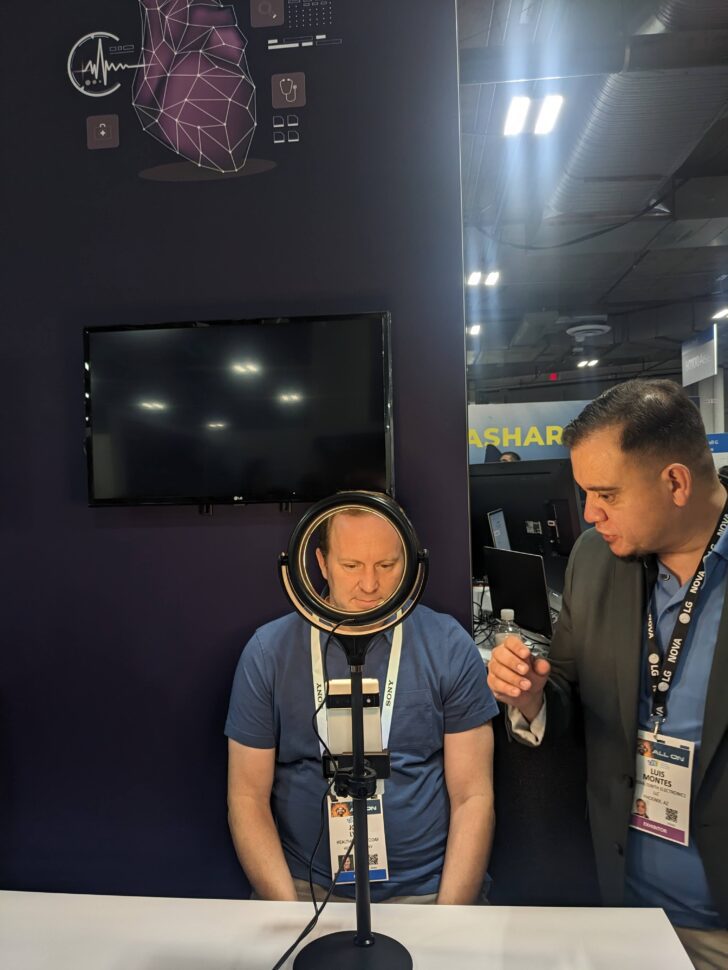
You’ll see that for this demo application I just have to center my face in the circle for about 60 seconds or so and the Informed tool analyzes all 4 vital signs. It was interesting to try and hold still for this. Also, they were showing a real time feed of the 4 results based on what it was able to assess which I assume probably won’t be in the final product, but was fascinating to watch.
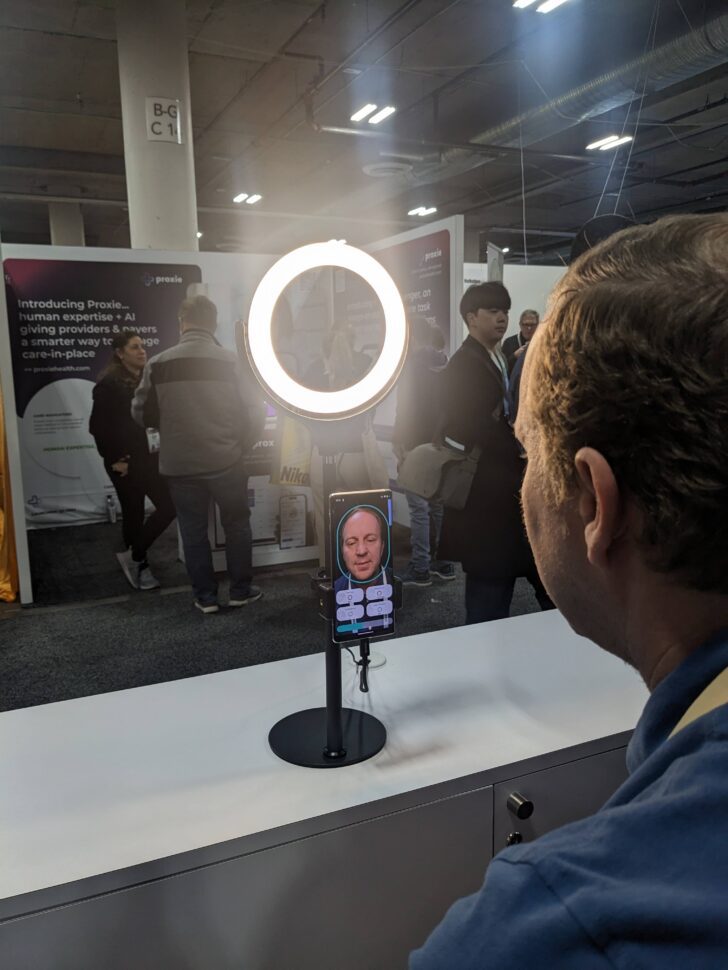
Finally, it showed me my completed test results. They said that they felt pretty solid on the heart rate and blood pressure was coming along. The breathing rate and oxygen saturation was still something they were working to refine and needed more data to ensure its accuracy. I wish I’d had a ring or watch on to compare data, but I didn’t at the time.
It’s also worth noting that what you see below is just a basic demo application. Informed likely won’t be the one creating the application they use. Instead, they’ll license their technology to other digital health applications that want to incorporate this data into their use cases.
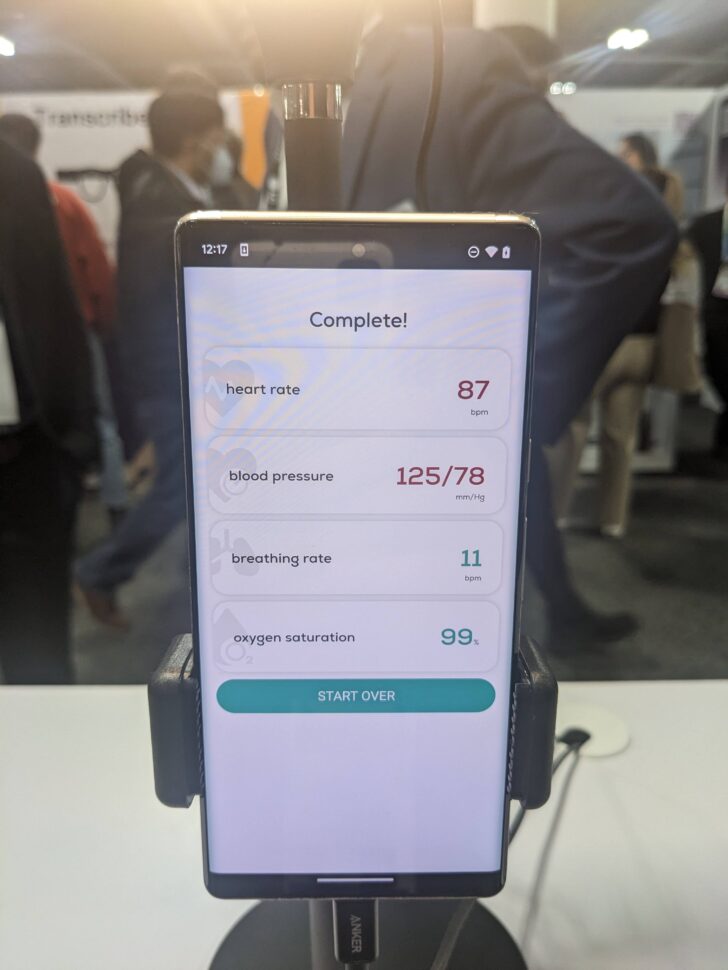
It’s not hard to see how these video vital signs are going to be a great way to remotely monitor a patient. I’m excited for these applications to clear the FDA process so that doctors and medical providers will trust them and can start using them.
MVITRO No Prick Glucose Monitor
One of the coolest things I saw at CES in the health space was the Blood Glucose Monitor from MVITRO. I’ll admit that this is really a medical device which we don’t cover much on this site (and it not often found at CES), but considering I literally gave blood to test out the MVITRO product, I figured I’d share it.
The MVITRO device uses a laser instead of a needle prick to draw blood to test your glucose levels. As you’ll see in the video below, the laser didn’t hurt at all. You literally hear me say, it just felt like someone was touching me. Then, you see how they’re able to get the blood and do the regular test of your blood sugar using test strips and the laser device. What’s even more interesting is that he just wiped the site off, but there was no need for a bandaid or anything. The site did feel slightly off for a few minutes after, but it was essentially painless. They told me that with this device you can use the same finger and it doesn’t build up the same scar tissue that a prick does. I remember my grandfather who had diabetes for 30 years looking at his fingers to decide which one he should use because of all the built up scar tissue.
Check out this video to see the MVITRO in action:
After they did the laser “prick” (if you will), they asked everyone to put a sticker on this chart to describe how the laser experience felt. It’s a pretty compelling sign. They might need to submit it for a Swaay.Health Marketing Award.
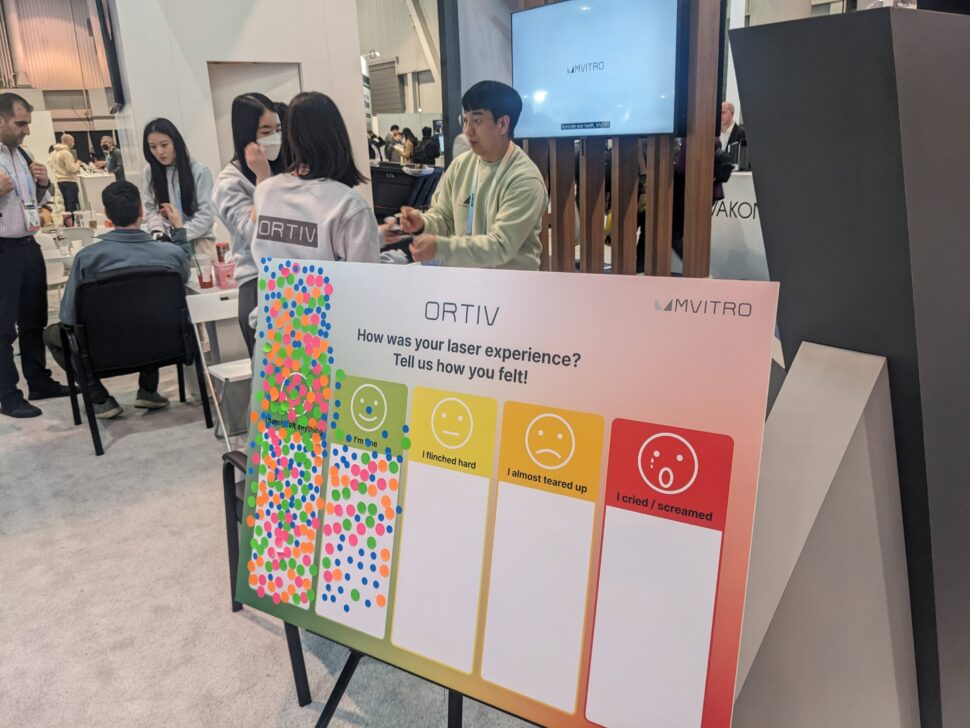
I heard that someone at CES was working on a glucose monitor that didn’t require blood. I didn’t see it though, so I’m not sure how that works and where it’s at in the process of FDA approval, etc.
C.Light Technologies – Alzheimers, Concussions, and More
I was really impressed with a company called C.Light Technologies that was also at the LG booth. I’ll admit that the work they’re doing is way beyond me and needs a doctor to evaluate it properly. However, the base concept is pretty simple and seems to show a lot of promise. Your eye movement is a reflection of your brain. The C.Light Technologies (as you see below) analyzes your eye movement to help evaluate your brain health.
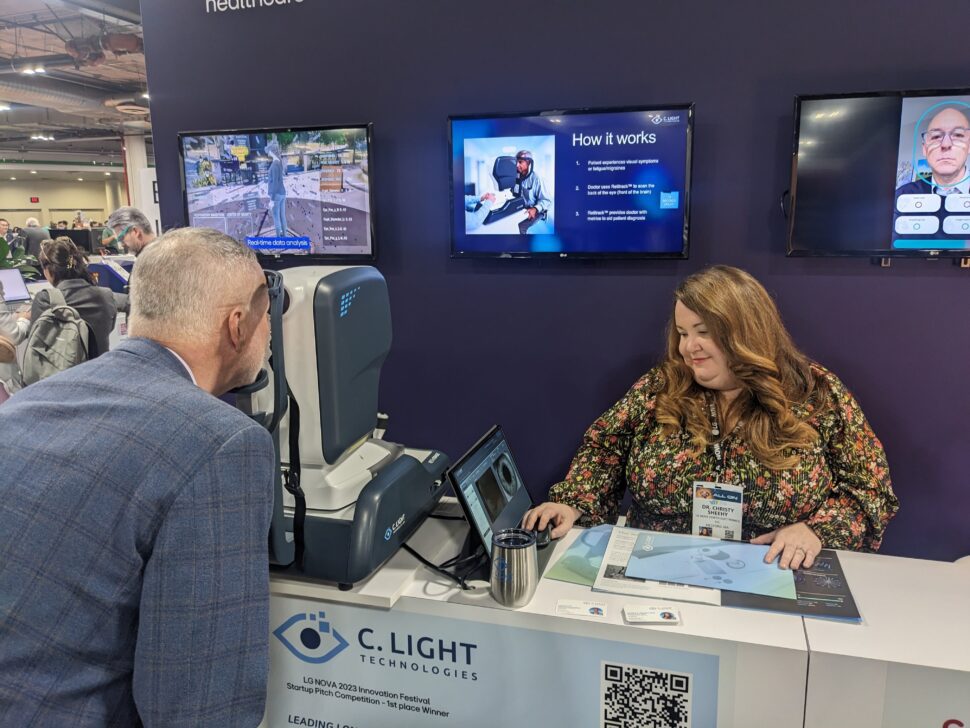
C.Light Technologies is still in the early stages of taking this product from concept to FDA approval, but they’re well on their way to that in a few areas. Some of the areas they’re looking at using this eye movement for is Alzheimer’s, concussions, and retinal diseases. I love their novel approach to analyzing eye movement to be able to address various neurodegenerative diseases, neuroinflammatory diseases, brain injuries, concussions, and retinal diseases. They tell me they’re working on a smaller form factor than what’s pictured above too.
Like I said, I’m not a doctor and so I’ll the medical professionals do the deep dive into this technology. Plus, C.Light Technologies is working on the proper FDA approval and clinical studies to validate their device, but it seemed to show a lot of promise.
M2 Test – Bone Density Testing
I’ll admit that M2 Test was most interesting to me because they were from Italia (Italy). Every year there’s a section of CES that includes companies from Italy. Anyone that knows me knows that I love Italy, so I go over there asking if they have any digital health companies. Plus, it looks like I’m going to take part in HIMSS Europe 2024 in Rome this year (Let me know if you’d like to do some paid videos at the event so Colin is glad I’m there) and so I wanted to meet more digital health companies from Italy.
My Italian bias aside, what M2 Test is doing is pretty interesting. They’re using some standard radiology reads and using their AI solution to evaluate bone density. Considering the number of fractures that happen, you can see how this can be a valuable tool. Plus, it’s important to remember that there are a lot of factors that can hurt or help bone density which changes over time. Tracking it and knowing what is helping and what is hurting is really interesting. Again, I’m not a doctor, but it was interesting to see M2 Test working on this important problem.

RingConn Smart Ring
One of the busiest booths in the Digital Health space at CES 2024 was the RingConn booth. I won’t dive into too many details here, since they gave me one to try out. Once I’ve had time to use it for a bit, I’ll share a full demo of the RingConn smart ring in a future article. I will say it’s a pretty stylish ring and I love the battery life too. More details to come.

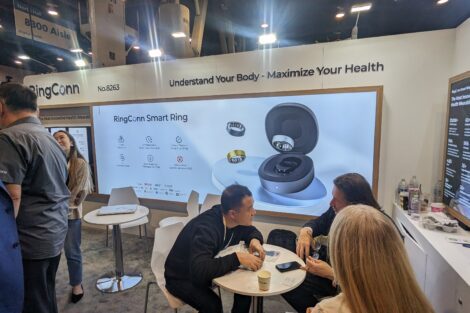

Withings BeamO – Multi-use Health Monitoring Device
The Withings BeamO was also another big hit at CES 2024. I actually did a full video interview with the Withings team in a really cool space they’d created to share the new product. The picture below just gives you a small look at the space. Watch for the full video interview about the Withings BeamO coming soon.
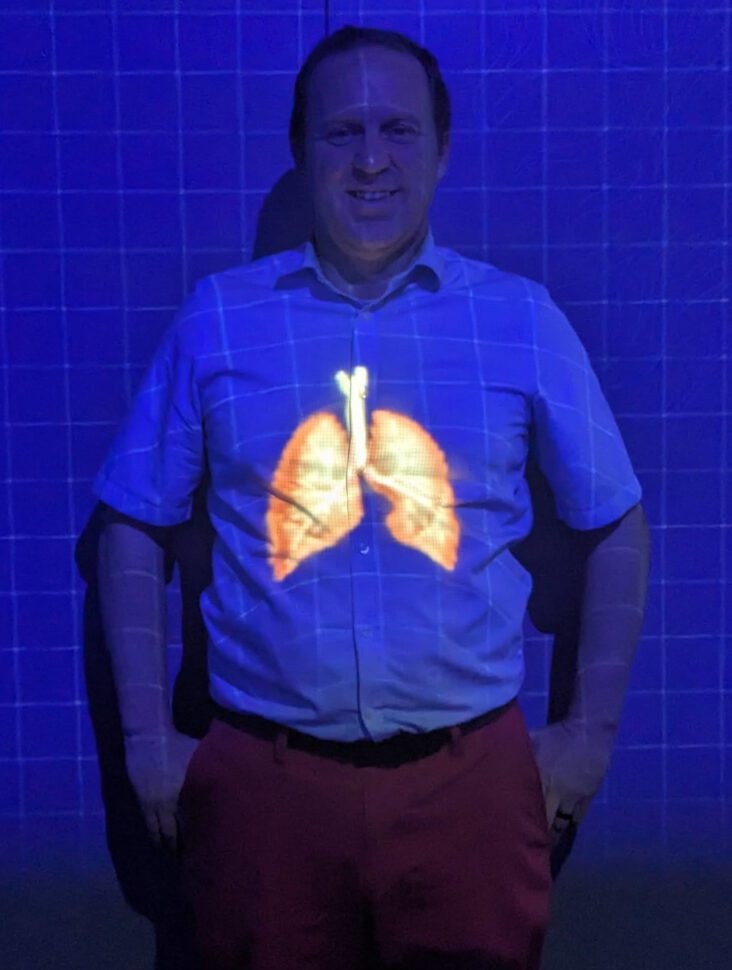
What did you see or hear about when it comes to Digital Health at CES 2024? What did I miss that I’m going to have FOMO for not seeing it? Let us know in the comments or on social media.
< + > EHR migration pays big dividends for Oak Orchard Health
< + > Fix daily irritants to reduce clinician burnout, KLAS says
Tuesday, January 23, 2024
< + > Singapore Armed Forces Medical Corps gets EMR lift
< + > 5 steps to strategic SDOH integration
< + > Key Skills and Qualifications for a Successful Career in Health IT and How They’ve Evolved with Advancements in Healthcare Technology
Having a career in Health IT requires a lot of skills and qualifications, even more so if you want that career to be successful – but what are those skills and qualifications? We all know what skills and qualifications we needed when we first entered the field, but regardless of how long you’ve been working in Health IT, the field has changed a lot since then. So what are these key skills and qualifications and how have they evolved with advancements in healthcare technology?
We reached out to our incredible Healthcare IT Today Community for their thoughts and the following is what they had to say.
Tom Liddell, CEO at Harmony Healthcare IT
A successful career in health IT leadership requires a unique blend of technical expertise, regulatory knowledge, and strong communication skills. A solid foundation in data infrastructure, security, and privacy protocols is crucial for anyone in 2024 looking to succeed in the healthcare industry. Familiarity with interoperability standards is also essential, as is the need to stay abreast of evolving compliance requirements.
IT leaders in healthcare must demonstrate commitment to continuous learning and professional development. The ability to translate complex technical information into understandable terms for diverse stakeholders is critical. Overall, the key skills and qualifications for success in this area involve a combination of technical proficiency, regulatory and security acumen, and interpersonal skills, all of which contribute to the effective implementation and management of healthcare technology solutions–ultimately ensuring the secure and compliant handling of critical data.
Patrick Schiess, President and Chief Information Security Officer at Darena Solutions
Development teams need a well-rounded skill set to create compelling healthcare IT products. Recognizing this, successful leaders will prioritize the integration of software engineers with solid product design and user experience expertise. Investing time in client research and meticulous planning pays off by producing user-friendly and need-fulfilling products. This approach enhances user satisfaction and energizes software engineers, who can focus on their strengths rather than stretch into unsuitable roles.
Emphasizing the significance of design in innovation, health IT leaders are encouraged to dedicate resources to robust design cycles and to bring professional designers on board. This strategy leads to superior products and a collaborative environment for all team members.
Brian Urban, Director of Innovation and Emerging Markets at FinThrive
Developing into a healthy leader within healthcare technology/IT requires you to be authentically (1) loving and (2) curious. This differs greatly from other industries, such as engineering, actuarial sciences, accounting, law, civil services, etc., where a traditional square box, black-and-white thinking prevails—a mindset handed down from generation to generation.
What makes healthcare technology leadership skills uniquely different is the constant need to approach challenges, competition, collaborations, and thresholds with a sense of love. In the realm of healthcare, developing new products for age-old problems requires an unwavering commitment to embracing unforeseen obstacles. Without a genuine love for improving lives through the products, policies, or procedures you’re introducing to the market, you risk staying in a transactional space devoid of deeper meaning. To authentically contribute to societal health, it’s crucial to accept failure as an integral part of the process. Bouncing back from failures swiftly and delivering creative solutions is essential for meaningful progress in healthcare.
The second aspect is being curious—a complementary trait to the concept of being loving. Continually taking meaningful creative risks that lead to the next innovation or progress is a crucial part of becoming a successful healthcare leader in technology and IT. Investigating and finding ways to win and positively impact the lives you serve are fundamental components of this leadership skill set, setting it apart from other industries. Being academically strong greatly contributes to a healthcare leadership mindset. Most high-performing academic institutions in healthcare, technology, and innovation are well-versed in policies, procedures, and regulations at the state and federal government levels.
There are unique ways to stay informed, including staying connected with state-based associations, health plans, and regional healthcare finance organizations directly linked to the latest government regulations from CMS and other contributors, such as NCQA. Staying close to leading academic institutions, research entities, and nonprofit organizations reporting to government bodies provides the best way to stay informed about new regulations, policies, procedures, and opportunities for securing funding for accelerated projects and programs.
Wes Wright, Chief Healthcare Officer at Ordr
A successful career in Health IT requires the same skills and qualifications needed for a successful career in any other field: it all starts with communication and empathy. If you don’t understand the needs of your customer, whoever that might be, then you can’t meet those needs. The only way you can do that is through communication and empathy
Shawn Gingrich, VP of HR at Azalea Health
Successful Healthcare IT professionals must excel in three skill sets in today’s quickly evolving climate: Collaboration on project management with multiple internal/external clients, execution of an impenetrable threat management program, and compliance with ever-changing regulatory requirements.
Caryn Hewitt, RN, BSN, CENP, CPHQ, Senior Director of Consulting Services at CenTrak
One of the first things I recommend is an understanding of what clinicians do and a background or career already in an area of the clinical world. It is crucial to have a good understanding of what the clinical folks are doing, why they are doing it, the tools they’re using in their day-to-day, and what problems Health IT is trying to solve. This knowledge better allows those in Health IT to be inquisitive, ask questions, and really understand why they’re doing the things they’re doing.
I’ve also found that having excellent listening skills goes a long way, and I recommend entering conversations as a partnership. In other words, it’s best to understand the clinician’s world and not come across as ‘I’m going to tell you what I’m doing for you.’ In reality, you’re in this together.
Advancements in technology have changed the skillset required to perform health IT roles. Health IT workers have technology at their disposal, both in their daily lives outside of work and in their professional settings. The young professionals in today’s healthcare environment are incredibly smart, and this is partially because they bring with them an understanding of what technology can do for them, their team, and the healthcare business as a whole. With their understanding of both clinical needs and technology, they can more easily implement technology to positively impact clinicians’ time and effort and better inform the patient experience.
John Johnson, Chief Information Officer at Savista
IT professionals working in healthcare must, at a minimum, possess strong collaboration skills and foundational technical skills specific to their technology domain such as programming, security, data management, infrastructure, project management, and systems integration. To increase their value to their organizations, IT professionals should build their knowledge and skills to include expertise in EHR systems (ex., Epic), regulations and compliance requirements (ex., HIPAA), and healthcare data and interoperability standards (Ex., FHIR/HL7.) The combination of technical skills and industry knowledge are foundational for Health IT workers. However, looking forward to 2024 the healthcare technology landscape continues to evolve with new and maturing technologies such as Generative AI, Machine Learning, Telehealth/Telemedicine, and Augmented Reality.
This evolution will challenge Health IT professionals to keep pace through continuous research, education, and application of these technologies. To achieve success in this rapidly evolving industry, Health IT professionals should include in their 2024 plans a focus on:
Artificial Intelligence: AI is in its infancy and many organizations are ‘experimenting’ with AI-enabled use-cases to drive business value. Health IT professionals must partner with business stakeholders to drive AI benefits while maintaining appropriate security and compliance standards.
Cybersecurity: Health IT professionals need to incorporate Cybersecurity best practices into all areas of the business to effectively protect sensitive data from security threats. A formal Cybersecurity program can provide a framework for managing emerging security threats.
Interoperability: Healthcare systems no longer operate stand-alone. Standards like FHIR are enabling interoperability which delivers healthcare data exchange between different systems. Adoption and management of interoperability are required to compete in the Healthcare services industry.
Patient Experience: Applying technology such as patient portals to enable communication and self-service can improve the overall patient experience, improve patient engagement, and drive operational efficiency. Portals provide the patient with 24×7 access to messaging, scheduling, and billing/payment capabilities which reduce administrative burden and enhance the patient experience. Health IT professionals must design and build these systems with strict adherence to privacy and data security regulations.
So many great insights here! Thank you to everyone who took the time out of their day to submit a quote in to us and to all of you for taking the time to read this article! We could not do this without all of your support! What do you think are the key skills and qualifications needed for a successful career in Health IT and how have they evolved over time? Let us know either in the comments down below or over on social media. We’d love to hear from all of you!
< + > Hybrid Intelligence with Carta Healthcare – Life Sciences Today Podcast Episode 33
We’re excited to be back for another episode of the Life Sciences Today Podcast by Healthcare IT Today. My guest today is Aaron Brauser, Ge...

-
As I’m sure you know, times are tough. Wages have largely remained the same while prices have risen across the board – and healthcare is no ...
-
Welcome to the weekly edition of Healthcare IT Today Bonus Features . This article will be a weekly roundup of interesting stories, product ...
-
The following is a guest article by Ladd Wiley, Senior Vice President for Global Corporate Affairs, Public Policy, and Advocacy at Epic , ...
